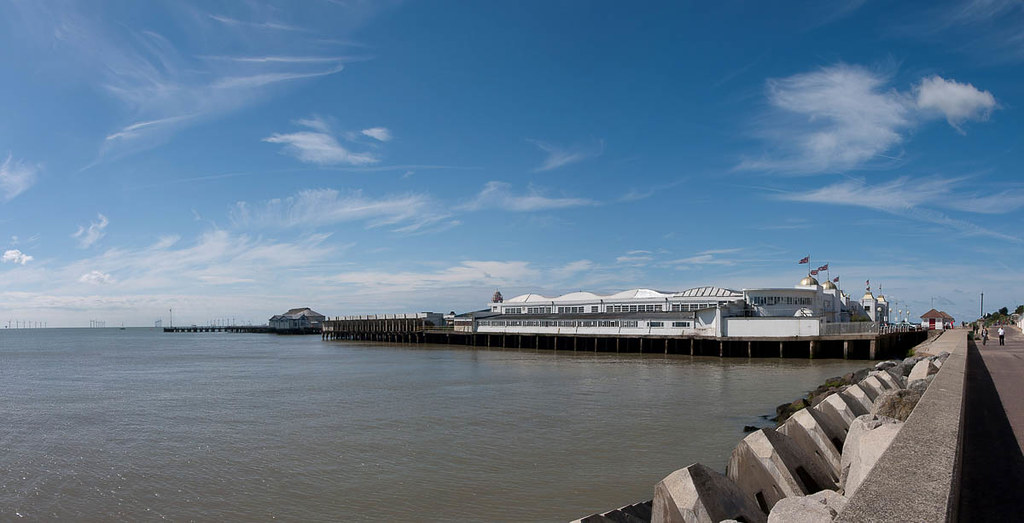In the light of this exercise however, I decided to re-visit them, take a couple more to stay with the spirit of the course and turn them into something viewable. My rather ancient copy of PSE2 gave up at this point so I downloaded a copy of Microsoft’s Image Composite Editor (ICE) which is an excellent little program capable of stitching directly from ORF (Oly RAW) files, and making a pretty reasonable job of it in the process.
Here’s one I took this Sunday morning of Clacton Pier:

Not the most exciting photo in the world, but pleasant enough, even so. I’ve cropped it to improve the balance, the 2:1 aspect ratio suits the subject, and to complete the scale there are a couple of people on the RHS. To give myself the headroom to crop it I shot with the camera in portrait format. The sky is interesting rather than dramatic, the perspective seems reasonably normal and the feel is almost intimate.
By contrast the following shot has a rather more ‘photographer as observer’ feel to it. Taken from the 13th floor of the Metropole Hotel in Interlaken, the lack of foreground distances the photographer from the subject, and the obvious scale of the background adds a dramatic touch.

At this point perspective is altered quite dramatically. On a screen at normal viewing distances I doubt it has an angle of view of more than 10-15 degrees, compared with the 100+ covered by the shot. I’m fairly clear in my own mind that this isn’t an issue. In spite of the visual compression, the 3:1 aspect ratio, the familiar scale of the buildings and the sweep of the road on the left all add up to a shot that talks of sweeping vista, which is the impression you get if you’re stood where the photographer (me) was at the time. The buildings in the middle ground balance the grandeur of the mountains so that there is no feel of threat – or the sublime – in this image. Not so the next:
 .
.
In this shot there is a sense of standing on the edge and facing a huge range of mountains – which we are - the Eiger is in the middle. To me this hints at the sublime, but the problem is that the depth of the image is now so small that it would have to be displayed very large indeed to get the full effect. Even printed about 8” tall (about the limit of the resolution available from the camera I used for the shot) the final photo would be more than 4 feet long.
One solution would be to take the shots with the camera in portrait mode to give more depth – in this case that would still maintain the distance between the photographer and the scene as there was little foreground to speak of, but I can see it might spoil the effect in places where there was lots of foreground. I also think that additional sky would help the effect by reducing the containment of the mountains by the frame.
So what happens if we stand the usual use of panoramas on its head and use them in confined space?. Well first off the become more difficult to assemble as minor differences in level can result in significant changes in perspective. In this next case it resulted in a bit of a mismatch at the bottom of the pool which required me to add a patch over the assembled panorama – but setting that aside, the panorama has played real tricks with the apparent space. This was really a rather crowded fairground scene, but in the photo the opposite appears true.

This seems a somewhat unlikely visual illusion given that I have squeezed around 180 degrees into a much smaller viewing angle. I guess it comes from the fact that I have effectively ‘unwrapped’ the view and presented it on a flat surface, and the eye/brain is fooled into thinking that I’m looking at a vista. I can see a similar effect in this photo of a rather tatty garden fence which is made to feel somewhat larger and more expansive than the reality.

Not quite sure what to make of all this at present. Creation of space on a 2d surface interests me as a technical exercise, and tinkering with apparent perspective in this way seems to be one approach to manipulation of space, if not creation of it.
No comments:
Post a Comment